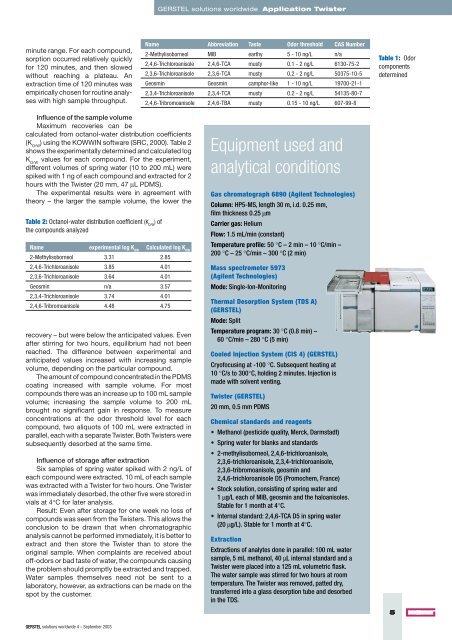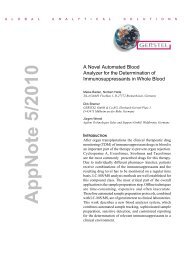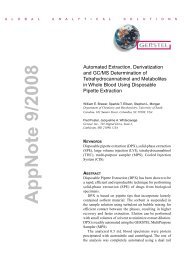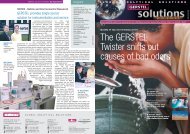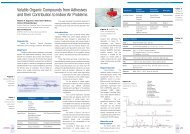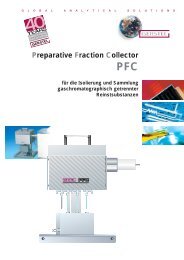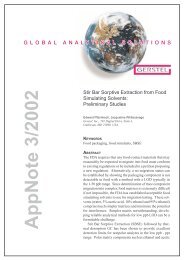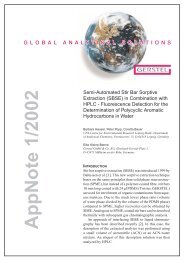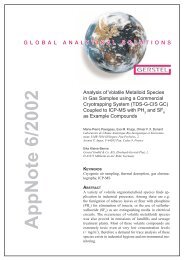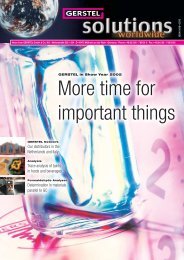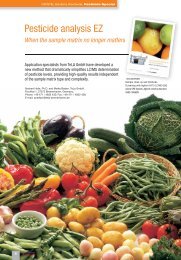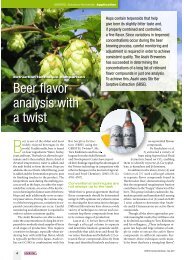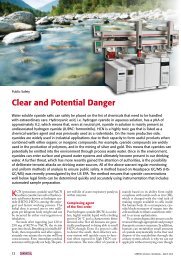GERSTEL Twister sniffs out causes of bad odors
GERSTEL Twister sniffs out causes of bad odors
GERSTEL Twister sniffs out causes of bad odors
You also want an ePaper? Increase the reach of your titles
YUMPU automatically turns print PDFs into web optimized ePapers that Google loves.
<strong>GERSTEL</strong> solutions worldwide Application <strong>Twister</strong><br />
minute range. For each compound,<br />
sorption occurred relatively quickly<br />
for 120 minutes, and then slowed<br />
with<strong>out</strong> reaching a plateau. An<br />
extraction time <strong>of</strong> 120 minutes was<br />
empirically chosen for r<strong>out</strong>ine analyses<br />
with high sample throughput.<br />
Name Abbreviation Taste Odor threshold CAS Number<br />
2-Methylisoborneol MIB earthy 5 - 10 ng/L n/a<br />
2,4,6-Trichloroanisole 2,4,6-TCA musty 0.1 - 2 ng/L 6130-75-2<br />
2,3,6-Trichloroanisole 2,3,6-TCA musty 0.2 - 2 ng/L 50375-10-5<br />
Geosmin Geosmin camphor-like 1 - 10 ng/L 19700-21-1<br />
2,3,4-Trichloroanisole 2,3,4-TCA musty 0.2 - 2 ng/L 54135-80-7<br />
2,4,6-Tribromoanisole 2,4,6-TBA musty 0.15 - 10 ng/L 607-99-8<br />
Table 1: Odor<br />
components<br />
determined<br />
Influence <strong>of</strong> the sample volume<br />
Maximum recoveries can be<br />
calculated from octanol-water distribution coefficients<br />
(K O/W<br />
) using the KOWWIN s<strong>of</strong>tware (SRC, 2000). Table 2<br />
shows the experimentally determined and calculated log<br />
K O/W<br />
values for each compound. For the experiment,<br />
different volumes <strong>of</strong> spring water (10 to 200 mL) were<br />
spiked with 1 ng <strong>of</strong> each compound and extracted for 2<br />
hours with the <strong>Twister</strong> (20 mm, 47 µL PDMS).<br />
The experimental results were in agreement with<br />
theory – the larger the sample volume, the lower the<br />
Table 2: Octanol-water distribution coefficient (K O/W<br />
) <strong>of</strong><br />
the compounds analyzed<br />
Name experimental log K OW<br />
Calculated log K OW<br />
2-Methylisoborneol 3.31 2.85<br />
2,4,6-Trichloroanisole 3.85 4.01<br />
2,3,6-Trichloroanisole 3.64 4.01<br />
Geosmin n/a 3.57<br />
2,3,4-Trichloroanisole 3.74 4.01<br />
2,4,6-Tribromoanisole 4.48 4.75<br />
recovery – but were below the anticipated values. Even<br />
after stirring for two hours, equilibrium had not been<br />
reached. The difference between experimental and<br />
anticipated values increased with increasing sample<br />
volume, depending on the particular compound.<br />
The amount <strong>of</strong> compound concentrated in the PDMS<br />
coating increased with sample volume. For most<br />
compounds there was an increase up to 100 mL sample<br />
volume; increasing the sample volume to 200 mL<br />
brought no significant gain in response. To measure<br />
concentrations at the odor threshold level for each<br />
compound, two aliquots <strong>of</strong> 100 mL were extracted in<br />
parallel, each with a separate <strong>Twister</strong>. Both <strong>Twister</strong>s were<br />
subsequently desorbed at the same time.<br />
Influence <strong>of</strong> storage after extraction<br />
Six samples <strong>of</strong> spring water spiked with 2 ng/L <strong>of</strong><br />
each compound were extracted. 10 mL <strong>of</strong> each sample<br />
was extracted with a <strong>Twister</strong> for two hours. One <strong>Twister</strong><br />
was immediately desorbed, the other five were stored in<br />
vials at 4°C for later analysis.<br />
Result: Even after storage for one week no loss <strong>of</strong><br />
compounds was seen from the <strong>Twister</strong>s. This allows the<br />
conclusion to be drawn that when chromatographic<br />
analysis cannot be performed immediately, it is better to<br />
extract and then store the <strong>Twister</strong> than to store the<br />
original sample. When complaints are received ab<strong>out</strong><br />
<strong>of</strong>f-<strong>odors</strong> or <strong>bad</strong> taste <strong>of</strong> water, the compounds causing<br />
the problem should promptly be extracted and trapped.<br />
Water samples themselves need not be sent to a<br />
laboratory, however, as extractions can be made on the<br />
spot by the customer.<br />
Equipment used and<br />
analytical conditions<br />
Gas chromatograph 6890 (Agilent Technologies)<br />
Column: HP5-MS, length 30 m, i.d. 0.25 mm,<br />
film thickness 0.25 µm<br />
Carrier gas: Helium<br />
Flow: 1.5 mL/min (constant)<br />
Temperature pr<strong>of</strong>ile: 50 °C – 2 min – 10 °C/min –<br />
200 °C – 25 °C/min – 300 °C (2 min)<br />
Mass spectrometer 5973<br />
(Agilent Technologies)<br />
Mode: Single-Ion-Monitoring<br />
Thermal Desorption System (TDS A)<br />
(<strong>GERSTEL</strong>)<br />
Mode: Split<br />
Temperature program: 30 °C (0.8 min) –<br />
60 °C/min – 280 °C (5 min)<br />
Cooled Injection System (CIS 4) (<strong>GERSTEL</strong>)<br />
Cry<strong>of</strong>ocusing at -100 °C. Subsequent heating at<br />
10 °C/s to 300°C, holding 2 minutes. Injection is<br />
made with solvent venting.<br />
<strong>Twister</strong> (<strong>GERSTEL</strong>)<br />
20 mm, 0.5 mm PDMS<br />
Chemical standards and reagents<br />
• Methanol (pesticide quality, Merck, Darmstadt)<br />
• Spring water for blanks and standards<br />
• 2-methylisoborneol, 2,4,6-trichloroanisole,<br />
2,3,6-trichloroanisole, 2,3,4-trichloroanisole,<br />
2,3,6-tribromoanisole, geosmin and<br />
2,4,6-trichloroanisole D5 (Promochem, France)<br />
• Stock solution, consisting <strong>of</strong> spring water and<br />
1 µg/L each <strong>of</strong> MIB, geosmin and the haloanisoles.<br />
Stable for 1 month at 4°C.<br />
• Internal standard: 2,4,6-TCA D5 in spring water<br />
(20 µg/L). Stable for 1 month at 4°C.<br />
Extraction<br />
Extractions <strong>of</strong> analytes done in parallel: 100 mL water<br />
sample, 5 mL methanol, 40 µL internal standard and a<br />
<strong>Twister</strong> were placed into a 125 mL volumetric flask.<br />
The water sample was stirred for two hours at room<br />
temperature. The <strong>Twister</strong> was removed, patted dry,<br />
transferred into a glass desorption tube and desorbed<br />
in the TDS.<br />
5<br />
<strong>GERSTEL</strong> solutions worldwide 4 – September 2003


